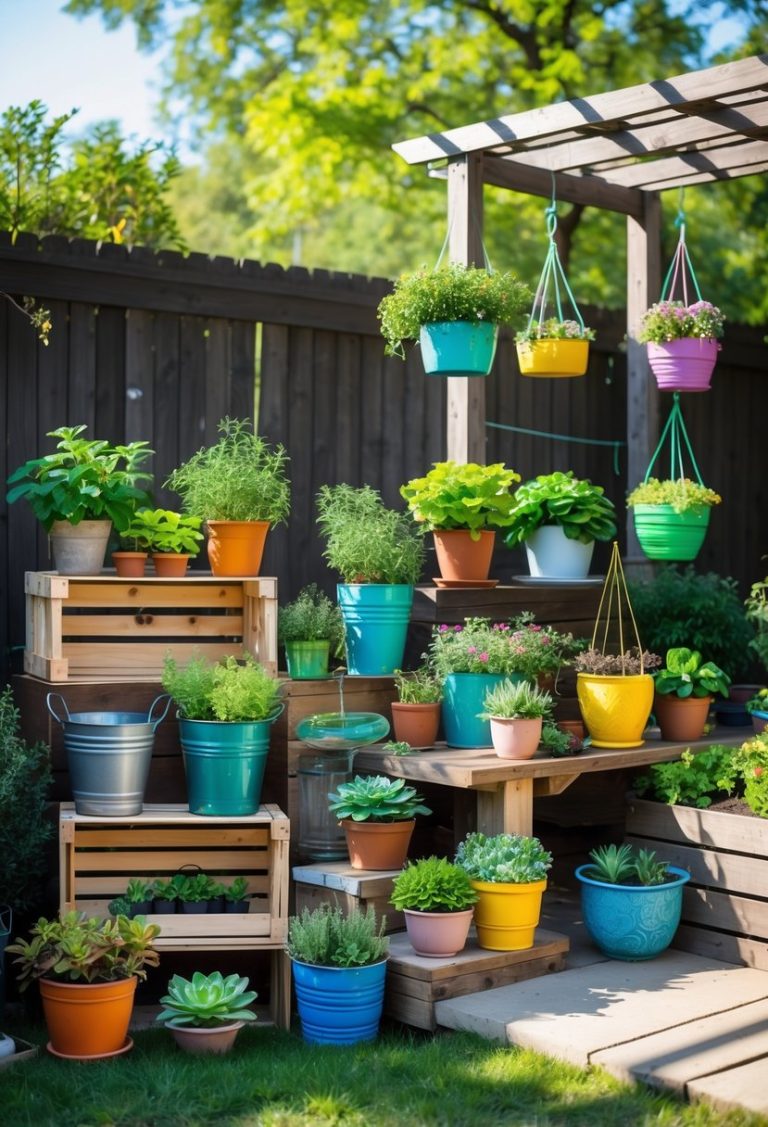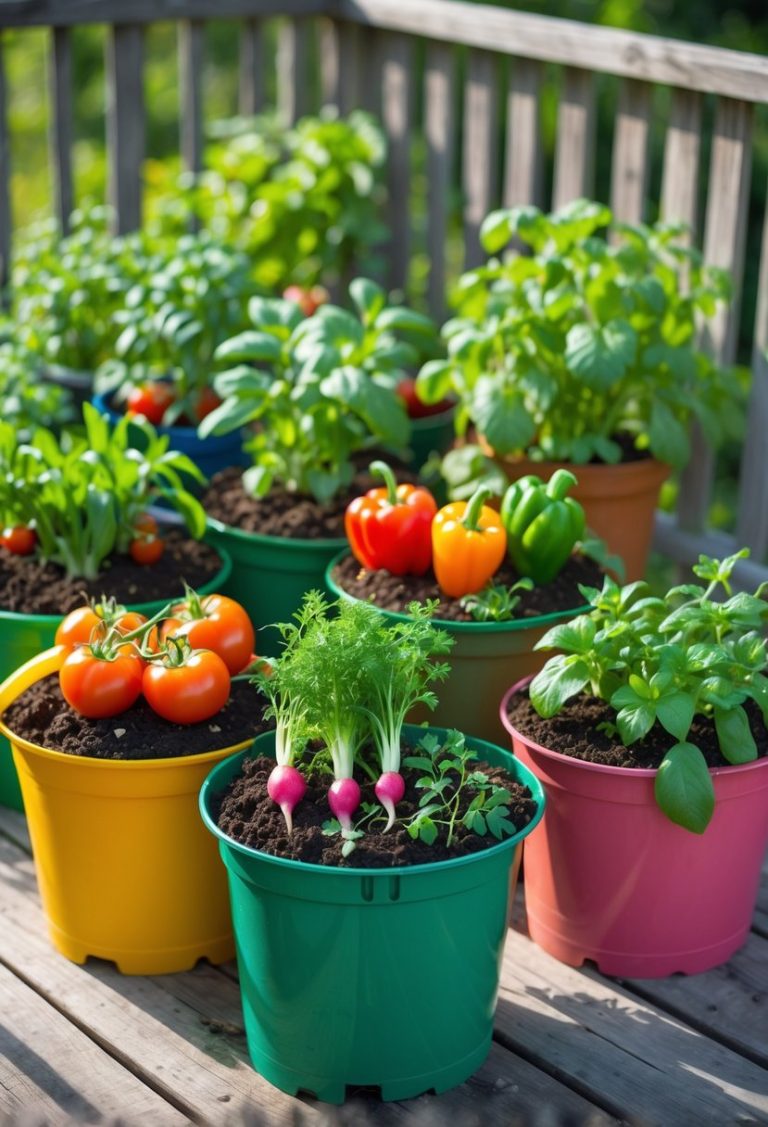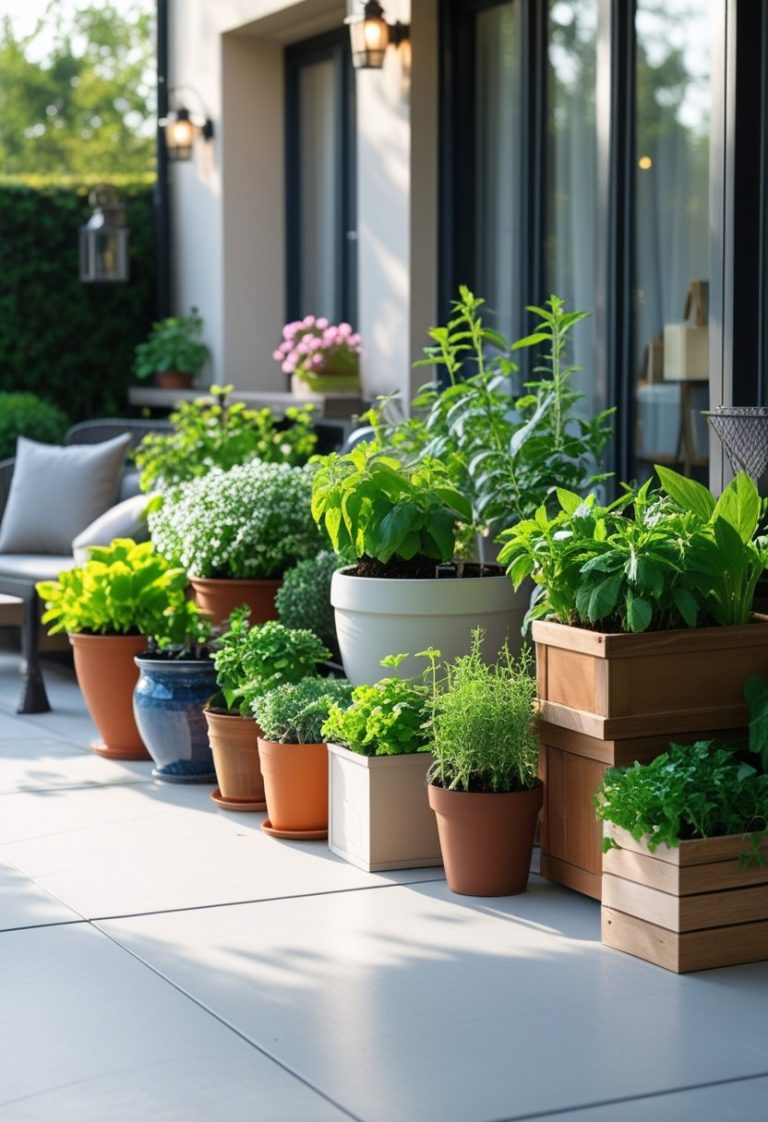15 Container Gardening Flower Ideas for Vibrant Small Space Gardens
Growing flowers in containers brightens any space and makes gardening accessible for all skill levels. Container gardening allows people to choose flowers that thrive in small spaces while adding vibrant color and texture to patios, balconies, or porches. It offers flexibility to mix and match blooms, giving gardeners unlimited design options.

Many flower varieties work well in pots, from sun-loving canna lilies to shade-tolerant fiber optic grass. Combining different plants enhances the visual appeal with varied shapes and colors. For those with limited budgets or space, simple container gardens still create an impressive floral display with easy care.
This post shares 15 container gardening flower ideas that fit various sunlight, space, and style needs. These ideas include creative combinations and practical tips to help anyone grow healthy, beautiful flowers in containers.
Key Takeaways
- Choosing the right flowers for containers helps ensure success.
- Mixing plant types creates more attractive arrangements.
- Easy, affordable strategies make container gardening enjoyable.
Choosing the Best Flowers for Container Gardening
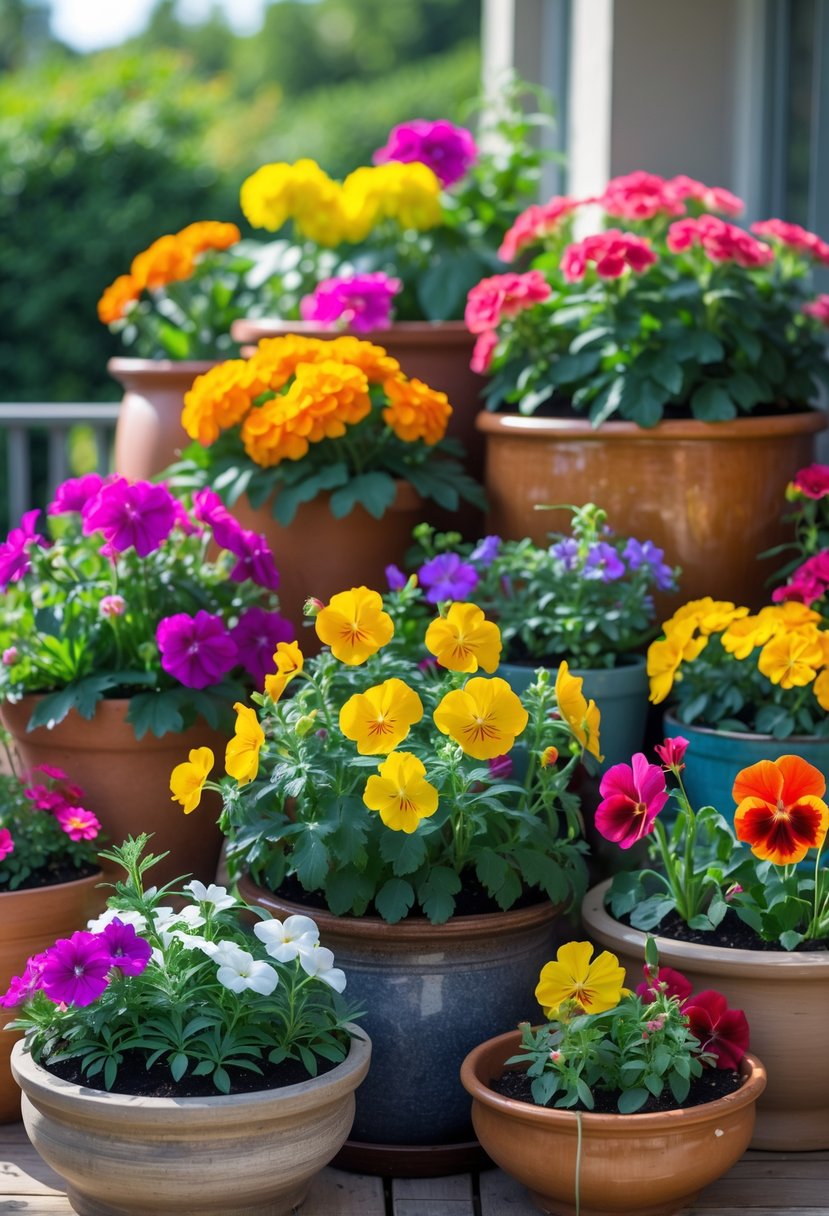
Picking the right flowers depends on where the container will be placed and how much sunlight the plants will get. The bloom season also matters to ensure flowers thrive and keep the pot colorful. Some plants need full sun, while others grow better in shade. Timing the blooms can give steady color throughout the year.
Selecting Flowers for Full Sun
Flowers that grow in full sun need at least six hours of direct sunlight daily. They should handle heat and dry soil well in containers. Common choices include petunias, marigolds, and zinnias. These plants produce vibrant colors and keep blooming through summer.
Full sun flowers usually need regular watering since pots dry out quickly. Using pots with drainage holes helps prevent root rot. Combining tall “thriller” flowers like salvia with medium “filler” plants and trailing “spiller” varieties can create a balanced look.
Shade-Loving Varieties
Shade containers get less than four hours of direct sunlight or filtered light. Shade-loving flowers like impatiens, begonias, and fuchsias do well here. These plants prefer cooler conditions and moist soil without drying out.
Shade containers should be placed where sunlight is limited but air flows freely to avoid mildew. Choose flowers that stay healthy even without intense light. Mixing different leaf shapes and colors can add texture and bright spots in low light areas.
Seasonal Blooms Selection
Choosing flowers based on bloom season ensures containers look fresh year-round. Spring bulbs like tulips and daffodils work well in pots and can be planted in early fall. Summer annuals such as geraniums and cosmos fill the containers with color.
In fall, chrysanthemums are a good option because they tolerate cooler weather. Some perennials like pansies also bloom in late fall to early winter if protected. Planning blooms by season allows for replacing or rotating plants as the year progresses.
For more guidance on balancing color and textures in pots, see tips on flower and plant combinations for container gardens.
Creative Flower Container Combinations
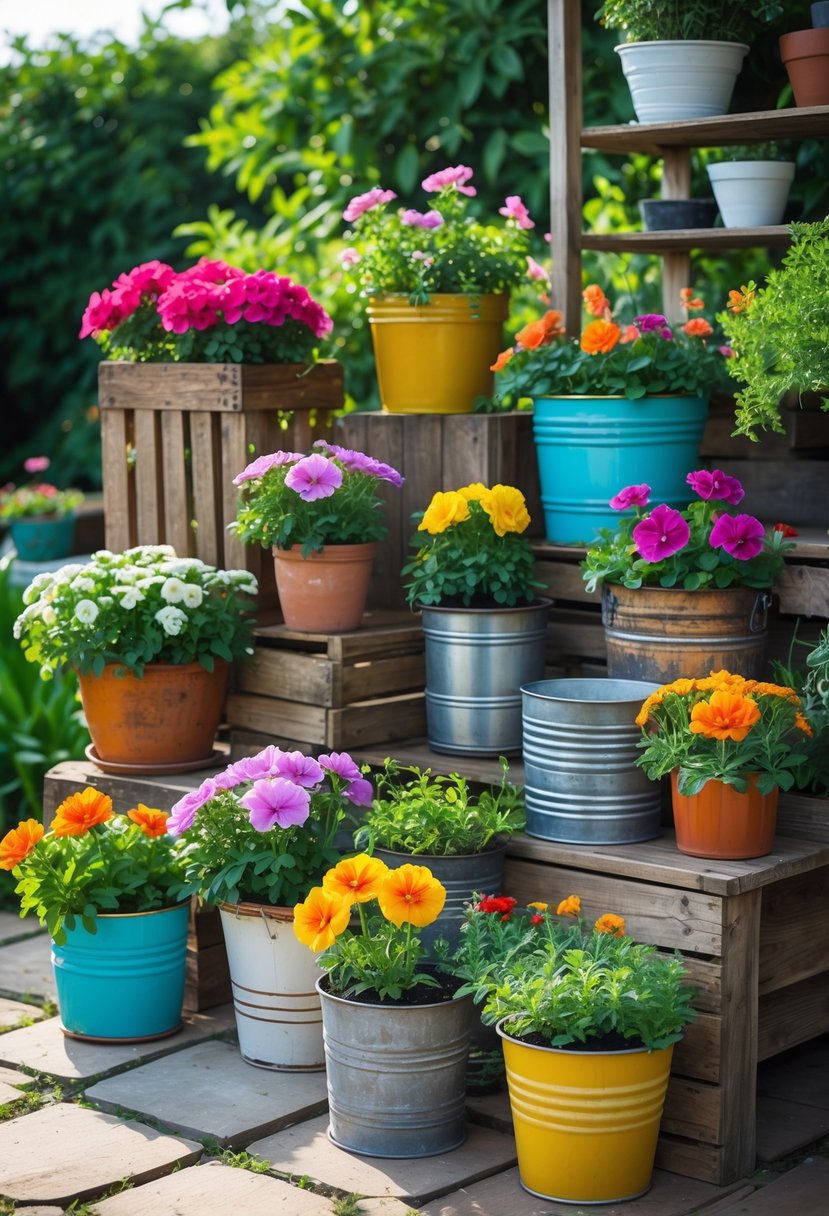
Choosing the right mix of flowers can turn any container into a striking garden feature. A well-planned combination balances height, color, and scent to create interest from every angle. Each container can showcase a unique style by blending shapes, shades, and fragrances thoughtfully.
Thriller, Filler, Spiller Arrangements
A popular way to design container gardens is by using the thriller, filler, spiller formula. The thriller is the focal point—usually a tall plant or one with bold texture that draws the eye upward. Examples include canna lilies or tall dahlias.
Next, fillers surround the thriller with medium-height plants that add volume and color without overwhelming. Petunias, marigolds, and dusty miller work well here because they bring both lush foliage and bright blooms.
Finally, spillers trail over the pot edges, softening the container’s lines and adding movement. Examples are creeping jenny or dichondra, which flow naturally and fill empty gaps. This formula helps create depth and balance in container gardening flowers combinations.
Color-Themed Containers
Focusing on one or two main colors can create a bold visual impact. For example, a container with shades of purple and white offers contrast while feeling harmonious. Using various hues of the same color—like light pink, magenta, and deep rose petunias—adds interest without clashing.
Choosing plants with different leaf textures and flower sizes enriches the container’s look even within a single color scheme. Bright yellow marigolds paired with dark green foliage can brighten shady spots on porches or patios.
Mixing complementary or analogous colors creates a smooth transition that’s pleasing to the eye. More container gardening flowers ideas and detailed palettes can be found in collections like full sun flower container ideas for fresh inspiration.
Fragrant Pairings
Including fragrant flowers brings an extra sensory dimension to container gardens. Lavender, sweet alyssum, and scented geraniums are excellent choices for small spaces where fragrance can be appreciated closely.
Pairing strongly scented plants with milder ones helps balance perfume intensity. For instance, combining lavender with pale, non-fragrant petunias softens the aroma while maintaining visual appeal.
These fragrances attract beneficial pollinators like bees and butterflies, adding life to container gardens. Planning with scent in mind enhances the overall gardening experience and invites visitors to linger near the pots.
Budget-Friendly Container Flower Ideas

Saving money while creating a beautiful container garden is possible with smart choices. Using everyday items as containers and picking flowers that thrive without much care helps keep costs low.
Repurposed Containers
Using repurposed containers can cut costs and add unique charm to a garden. Items like old wheelbarrows, buckets, or even mason jars work well as planters. Mason jars are especially good for small herbs or flowers and can be labeled for easy plant identification.
Drainage is key. Small stones or gravel at the bottom of these containers prevent water buildup, which protects roots.
Repurposed containers also save space and add personality to patios or balconies. This approach not only lowers expenses but encourages creative reuse of materials already on hand. More ideas on this can be found in the budget-friendly DIY planters guide.
Low-Cost Flower Choices
Choosing flowers that are inexpensive and easy to grow helps keep container gardening affordable. Some good options for containers include marigolds, pansies, and petunias. These flowers are widely available and don’t require special care.
Perennials like coneflowers or black-eyed Susans come back each year, reducing the need to buy new plants. Additionally, mixing seeds with nursery-grown plants can lower upfront costs.
Using quick-growing annuals fills containers fast without waiting long. This balance helps maintain color and variety without increasing the budget. For more details on easy-care flowers in containers, see simple container flower garden ideas.
Expert Tips for Planting and Maintaining Flower Containers

Successful container gardening depends on good soil, proper watering, and regular care. Attention to these details helps flowers grow strong and look their best. Choosing the right soil, feeding schedule, and pruning habits keeps containers healthy over time.
Soil Preparation and Drainage
Good soil must balance moisture retention and drainage. Use a high-quality potting mix made for containers, not garden soil, which can hold too much water and cause root rot. Adding perlite or vermiculite improves aeration and helps excess water flow through.
Place containers with drainage holes to prevent water buildup. If your pot lacks holes, drill some or add a layer of gravel at the bottom to keep roots from sitting in water. Regularly check soil moisture by touching it; it should feel moist but not soggy.
Mix in slow-release fertilizer or organic matter like compost when planting to provide steady nutrients.
Watering and Feeding Strategies
Containers dry out faster than garden beds, so watering needs are frequent but controlled. Check containers daily, especially in hot weather. Water deeply until it flows out of drainage holes, ensuring all roots receive moisture.
Use room-temperature water to avoid shocking plants. Early morning watering reduces evaporation and fungal risks. Avoid letting soil dry completely, but also do not keep it soggy.
Feed plants every 2-4 weeks with a balanced liquid fertilizer. Follow package directions carefully. Alternatively, use slow-release pellets mixed into soil when planting to feed for months.
Deadheading and Pruning Techniques
Removing spent flowers, or deadheading, encourages more blooms and prevents seed formation. Pinch or snip flower heads just above the first set of healthy leaves or buds.
Prune leggy or overgrown stems to maintain shape and airflow. This reduces disease risk and helps plants use energy for growth and flowers instead of crowded branches.
Use clean, sharp scissors or pruning shears to avoid damage. Regularly check containers for dead or yellowed leaves and remove them promptly.
Regional Inspiration: Container Gardening Ideas for the UK
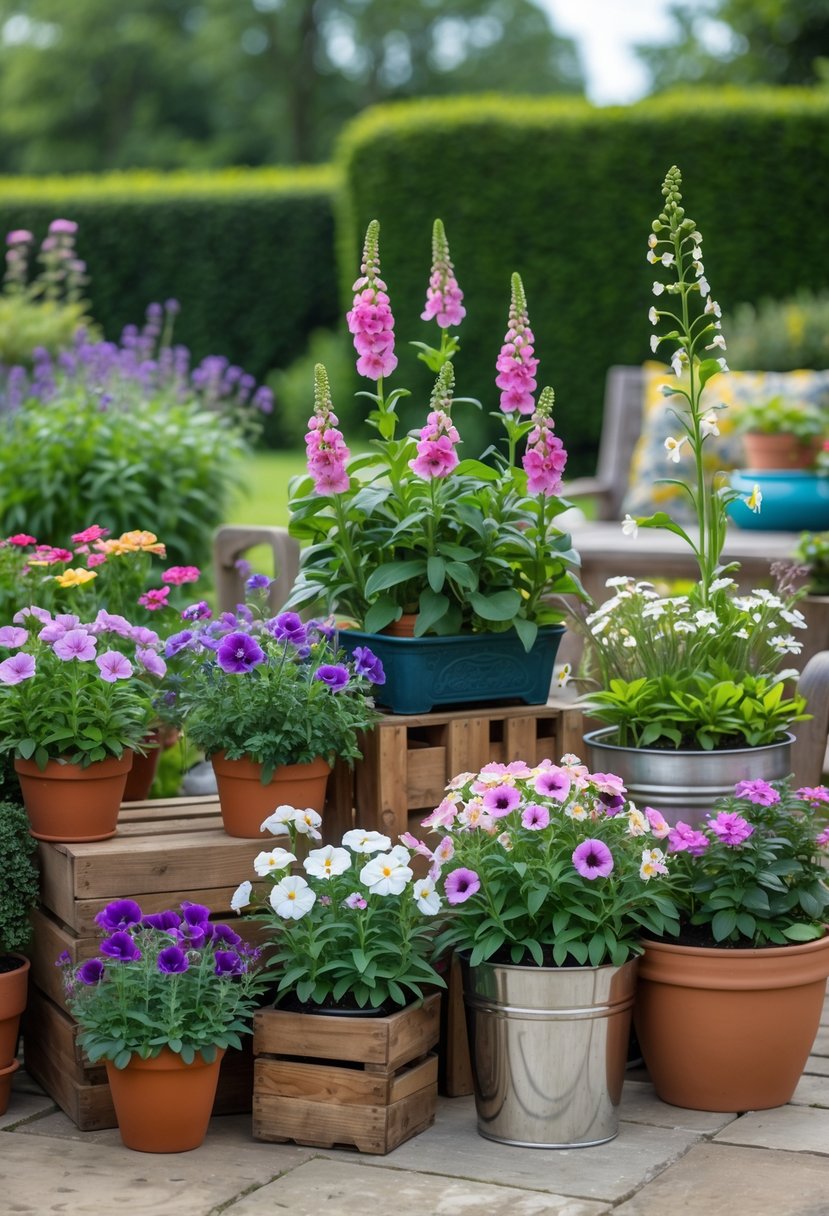
Container gardening in the UK requires plant choices and care routines that match the region’s cool, often wet climate. Understanding which flowers thrive in these conditions and the best maintenance practices can help gardeners achieve healthy, vibrant containers year-round.
Flower Choices Suited to UK Climate
Choosing flowers that cope well with the UK’s variable weather is essential. Hardy perennials like lavender, geraniums, and heuchera handle cooler temperatures and occasional rain. Annuals such as petunias and begonias provide strong colour during the summer months but may need shelter in colder or windy spots.
It helps to mix flowering plants with evergreen foliage like box or small conifers to keep containers looking good even in winter. UK gardeners often add bulbs like daffodils or tulips for spring impact. When arranging container gardens, ensuring good drainage and positioning pots in a spot with partial sun will improve plant health and reduce rot risk.
Seasonal Maintenance Tips for the UK
Spring and summer call for regular watering, especially as outdoor pots dry faster than garden beds. In the UK’s rainy seasons, gardeners should check drainage holes to prevent waterlogging.
Fertilize containers monthly during the growing season with a balanced feed to encourage blooms and healthy growth. Deadheading spent flowers keeps containers tidy and promotes more flowering.
In autumn, reduce watering and clear fallen leaves to avoid fungal diseases. Many UK gardeners protect roots with mulch or move more delicate plants indoors during winter frost. Regular monitoring for pests like aphids is useful all year, especially in sheltered container environments.
For more ideas on container gardening in the UK, visit 25 Must-Have Plants for UK Container Gardens.
Frequently Asked Questions

Many flowers thrive with little care and suit different light conditions. Choosing the right containers and avoiding common mistakes can improve plant health and appearance.
What are the low-maintenance flowers to grow in container gardens?
Petunias, marigolds, and geraniums need minimal care and can tolerate heat. They bloom for long periods and handle dry spells well.
Succulents and ornamental grasses also work well for low water needs and easy upkeep.
How do I choose plants for a full-sun container garden?
Select flowers that love sun, like zinnias, lantanas, and violet-flowered verbena. These plants tolerate heat and direct sunlight.
Make sure containers drain well to prevent root rot in sunny spots.
Can you suggest creative container ideas for outdoor plants?
Old wheelbarrows, wooden crates, or decorative metal tubs add charm and function as planters.
Grouping several small pots on a tiered stand also creates an attractive display for porches or patios.
Which flowers are best for year-round color in pots?
Mix winter pansies with spring tulips or daffodils, and summer begonias. Fall mums add late-season blooms.
Evergreen foliage plants ensure some color when flowers fade.
How to avoid common errors when planting in containers?
Avoid containers without drainage holes to prevent water buildup. Use good-quality potting mix, not garden soil.
Do not overwater; check if soil feels dry before watering again.
What are suitable flowers for small-sized plant containers?
Miniature roses, alyssum, and lobelia suit small containers. Their compact size keeps them from crowding the pot.
Choose plants with shallow roots and slow growth to fit smaller spaces.

